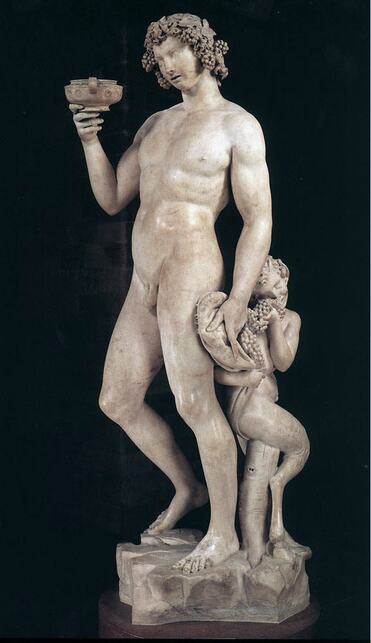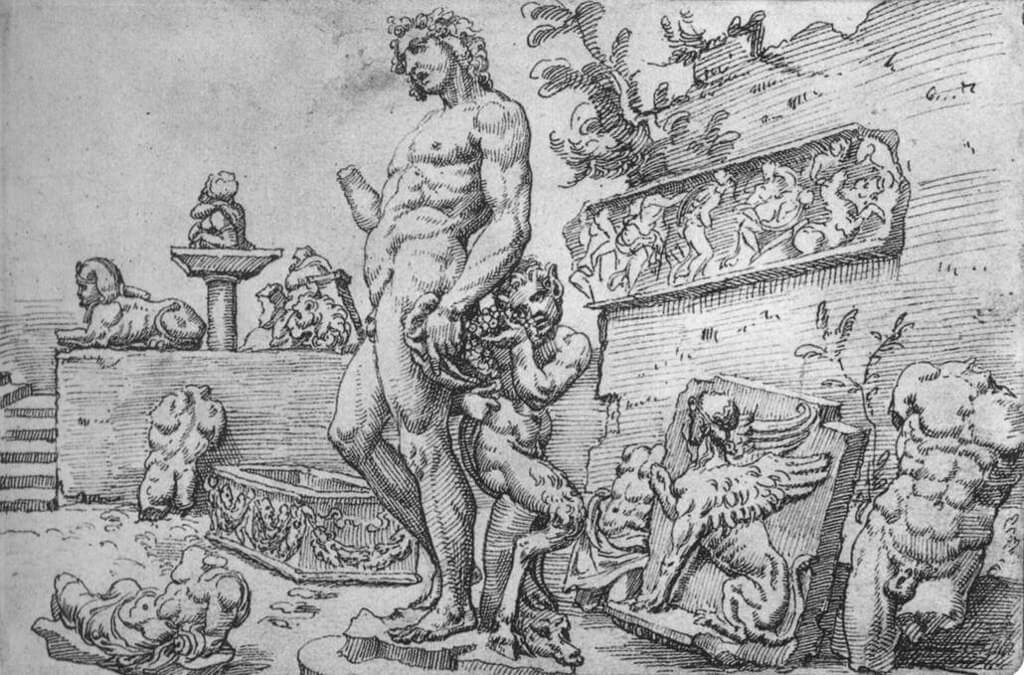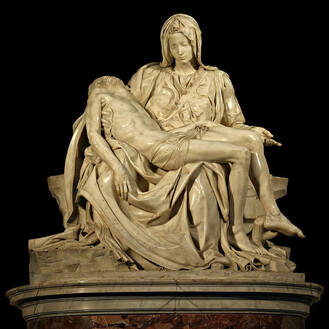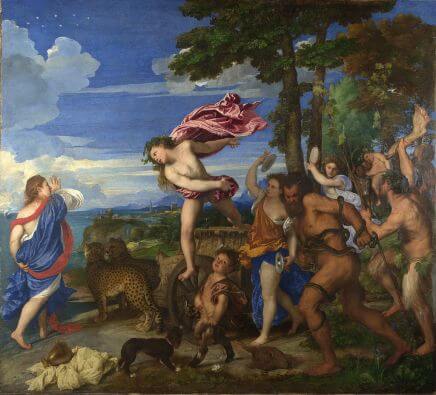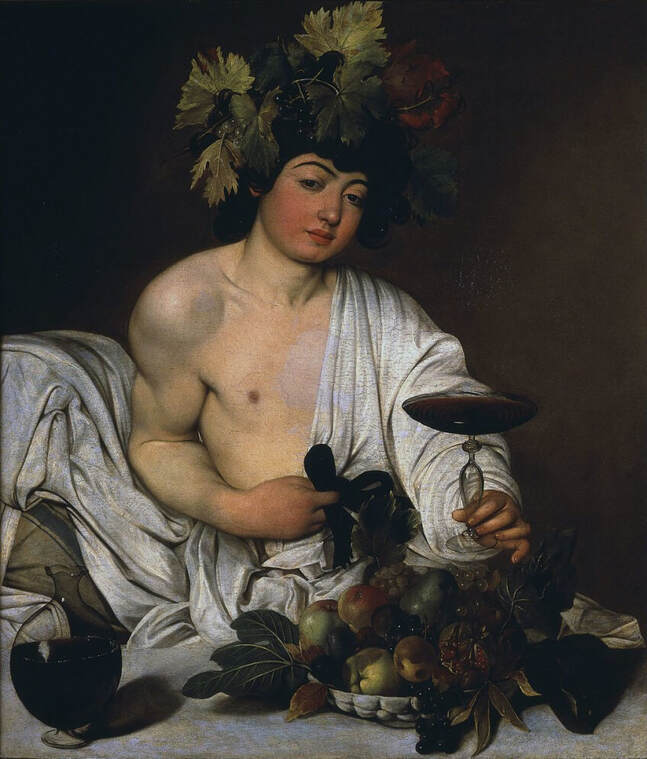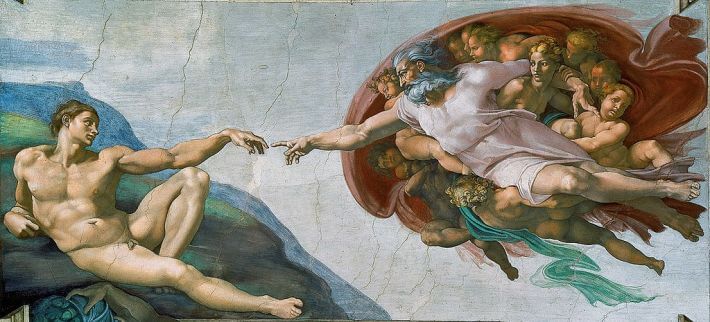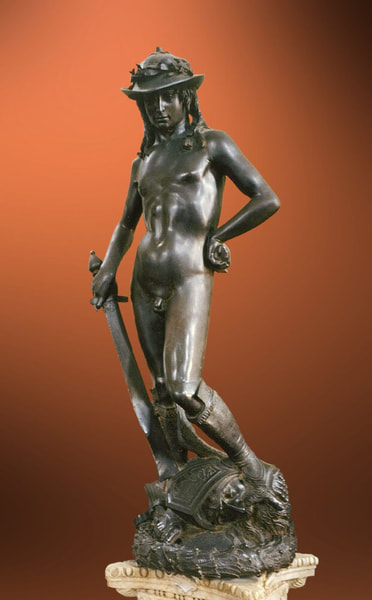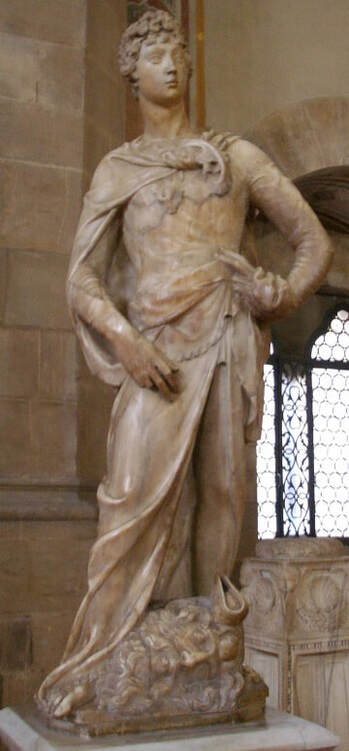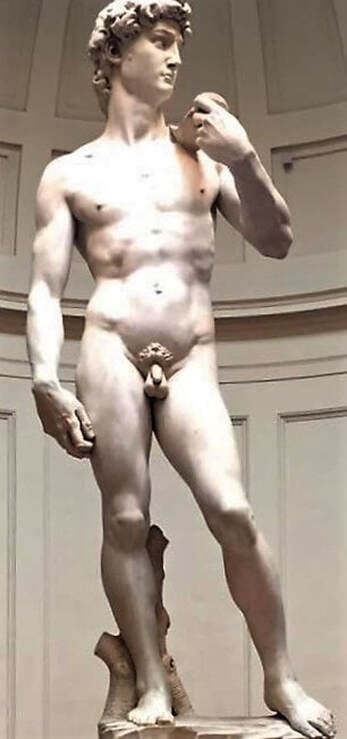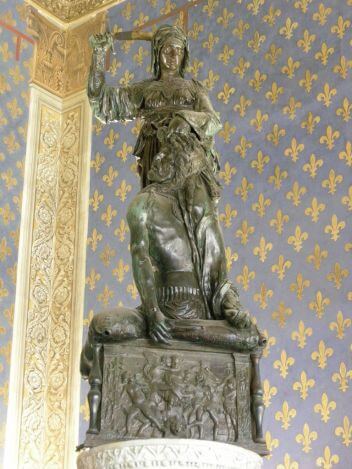|
Where? Room 3 on the ground floor of the Bargello Museum
When? 1496-1497 Commissioned by? Raffaele Riario, a cardinal and art collector. What do you see? A life-like statue of the Roman god Bacchus. He is naked and standing with a large cup of wine in his right hand. He has curly hair made up of grapes and a wreath of ivy leaves in his hair. The effects of drinking the wine are visible in the expression of his face and his unstable pose. Bacchus seems to be looking at the cup, but his eyes are rolling. His unstable pose can be seen best from the right side as illustrated in the drawing of Maarten van Heemskerck of this statue in the garden of its owner Jacopo Galli. Bacchus is leaning somewhat backward with his shoulders pulled back and his belly pointing forward. Interestingly, when we look from the left side, the body seems to be quite balanced. So, when walking around this statue, he sometimes seems to be out of balance and from other angles he seems quite stable. In his left hand, Bacchus is holding a large bunch of grapes and a piece of animal skin that touches the rock-like base. You can see the face of the animal from the back of the statue and some have suggested that this is a wolf, though there are several other opinions on what animal it is. Behind his left leg is a tree trunk for the stability of the sculpture. Next to Bacchus is a young satyr, which is a male figure with a permanent erection and with the ears, horns, legs, and tail of a goat. The satyr is smiling an eating from the grapes.
Backstory: Michelangelo started to work on this painting in July 1596 when he was 21 years old. Cardinal Raffaele Riario commissioned the statue. He had earlier bought a statue from Michelangelo, called Sleeping Cupid. But after he bought it, he discovered that the statue was not an antique one as was told to him, but rather a statue created by Michelangelo (the statue is now lost). Nevertheless, Riario’s interest in Michelangelo’s talents was triggered, and he commissioned him to make a statue of Bacchus.
Who is Bacchus? Bacchus is the Roman god of wine, intoxication, fertility, religious ecstasy, and drama. His equivalent in Greek mythology is Dyonisus. He is the son of Zeus, and there are different stories about who his mother is, but the most popular one is that his mother was Semele who was a mortal. Bacchus is often depicted with grapes, ivy leaves, wine, and satyrs (like in this sculpture).
Bacchus has been a source of inspiration for many artists in ancient Greece and during the Renaissance. For example, Titian made a painting on Bacchus and Ariadne which is in the National Gallery in London. Caravaggio also created a famous painting of Bacchus which is in the Uffizi Museum in Florence.
Fun fact: The penis of Bacchus is missing. It seems to have been removed by a chisel rather than broken off. Also, the erection of the satyr, which was typical for him, is not present. Moreover, a hand of the statue had broken off (see the drawing of Van Heemskerck above) but was restored before 1553. It is unknown who removed some of these parts, but some people suggest that it could have been Michelangelo himself to make the statue look more like one from ancient Greece (where some of those body parts were often missing).
Michelangelo’s intention with this statue was indeed to create it in the style of the Greek antique statues, and he succeeded in this as this statue was regularly mistaken to be a statue from ancient Greece. Michelangelo wanted the statue to be in this ancient style to prove that at 21 years old he would already rival the famous ancient Greek sculptors. In that way, he could establish his reputation quickly. Interested in a copy for yourself? Framed poster of statue (Amazon links).
3 Comments
Patrick A. Rodgers, CC BY-SA 2.0
Where? Room 7 on the first floor of the Bargello Museum
When? Uncertain, but sometime between 1425 and 1455 Commissioned by? Cosimo de’ Medici
Backstory: In 1408-1409, Donatello also created a sculpture of David. This marble sculpture, however, is clothed and can also be found in the Bargello. According to Vasari, the pedestal for the bronze statue of David is probably created by Desiderio da Settignano. This statue is the oldest surviving bronze since antiquity. Bronze was perceived to be the most precious metal after gold, and therefore it was considered to be a special statue.
Inscription: The base of this statue carried a Latin inscription, which can be translated as: “The victor is whoever defends the fatherland. God crushes the wrath of an enormous foe. Behold - a boy overcame a great tyrant! Conquer, O citizens! Kingdoms fall through luxury, cities rise through virtues. Behold the neck of pride, severed by the hand of humility.” This inscription was intended to remind the Medici family of how to reign Florence.
Symbolism: This statue symbolized the victory of humility (represented by David) over tyranny (represented by Goliath). The Medici family displayed this statue in the courtyard of the Medici Palace to remind them and others of their humility and strength, but also to justify potential violence against people who were against their regime. The statue was placed footsteps away from the famous Judith and Holofernes statue by Donatello which can now be admired in the Palazzo Vecchio. The cupids on the helmet of Goliath are a symbol of non-religious passion and are a reference to the pagan people who are defeated by God. The wreath of laurel on David’s head is an indication of his victory over Goliath.
Who is Donatello? Donato di Niccolò di Betto Bardi (c. 1386-1466), better known as Donatello, was born in Florence. He was a sculptor that was ahead of his time. He was initially trained in a workshop of a goldsmith. Early in his career he worked together with and learned from Lorenzo Ghiberti and Filippo Brunelleschi. He has created statues and reliefs using materials such as bronze, stone, wax, and wood. Together with Leonardo da Vinci, Michelangelo, and Raphael, he is considered to be one of the four greatest artists of the Renaissance.
Fun fact: It is assumed that Donatello was homosexual and some people argue that he created this nude statue of David deliberately in a daring erotic posture. The left wing of the helmet that runs all the way up the right leg of David until the groin is interpreted as another sign that this is a homoerotic statue. Homosexuality, however, was forbidden during that time in Florence, but Donatello’s good friend Cosimo de’ Medici defended him from insults and the law. Cosimo was known to appreciate very talented artists and therefore he overlooked some of the bad behaviors that they may display. Interested in a copy for yourself? Poster, canvas, or statue (Amazon links). |
Categories
All
|
- Home
- Blog
-
Museums
- Alte Pinakothek
- Art Institute of Chicago
- Baltimore Museum of Art
- Barber Institute of Fine Arts
- Bargello
- Barnes Foundation
- British Museum
- Church of Sant’Anastasia
- Cleveland Museum of Art
- Courtauld Institute of Art
- Detroit Institute of Arts
- Frans Hals Museum
- Galleria Borghese
- Gallerie dell'Accademia
- Getty Museum
- Guggenheim
- Hermitage Museum
- Kunsthistorisches Museum
- Kunstmuseum Basel
- Legion of Honor Museum
- Louvre
- Mauritshuis
- Metropolitan Museum of Art
- Musee d’Orsay
- Museum of Fine Arts in Boston
- Museum of Modern Art
- National Gallery in London
- National Gallery of Art
- National Museum in Poznań
- Norton Simon Museum
- Ny Carlsberg Glyptotek
- Palace of Versailles
- Palazzo Pitti
- Palazzo Vecchio
- Petit Palais
- Philadelphia Museum of Art
- Prado
- Pushkin Museum
- Ravenna Art Museum
- Rijksmuseum
- San Diego Museum of Art
- Santa Maria delle Grazie
- St. Peter's Basilica
- Städel Museum
- Statens Museum for Kunst
- Tate Britain
- Tate Modern
- Timken Museum of Art
- Uffizi
- Vatican Museums
- Wallace Collection
-
Artists
- Altdorfer
- Anguissola
- Berlin Painter
- Bosch
- Botticelli
- Boucher
- Bronzino
- Bruegel the Elder
- Brunelleschi
- Cabanel
- Caillebotte
- Canova
- Caravaggio
- Carpeaux
- Cezanne
- Cimabue
- David
- Degas
- Delacroix
- De Maria
- Donatello
- El Greco
- Fontana
- Fra Angelico
- Fragonard
- Gauguin
- Gentileschi
- Gericault
- Gonzalez-Torres
- Goya
- Hals
- Hogarth
- Hokusai
- Ingres
- Leonardo da Vinci
- Lippi, Filippo
- Longhi, Barbara
- Lorrain
- Makovsky
- Manet
- Massys
- Matisse
- Merian
- Michelangelo
- Mochi
- Modigliani
- Monet
- Panini
- Parmigianino
- Perugino
- Picasso
- Pisanello
- Raphael
- Rembrandt
- Renoir
- Reynolds
- Rivera
- Rodin
- Rubens
- Scultori
- Seurat
- Steen
- Tintoretto
- Titian
- Toulouse-Lautrec
- Turner
- Uccello
- Van der Weyden
- Van Dyck
- Van Eyck
- Van Gogh
- Van Hemessen
- Vasari
- Velazquez
- Vermeer
- Veronese
- Vigée Le Brun
-
Locations
- Books
- About Us

